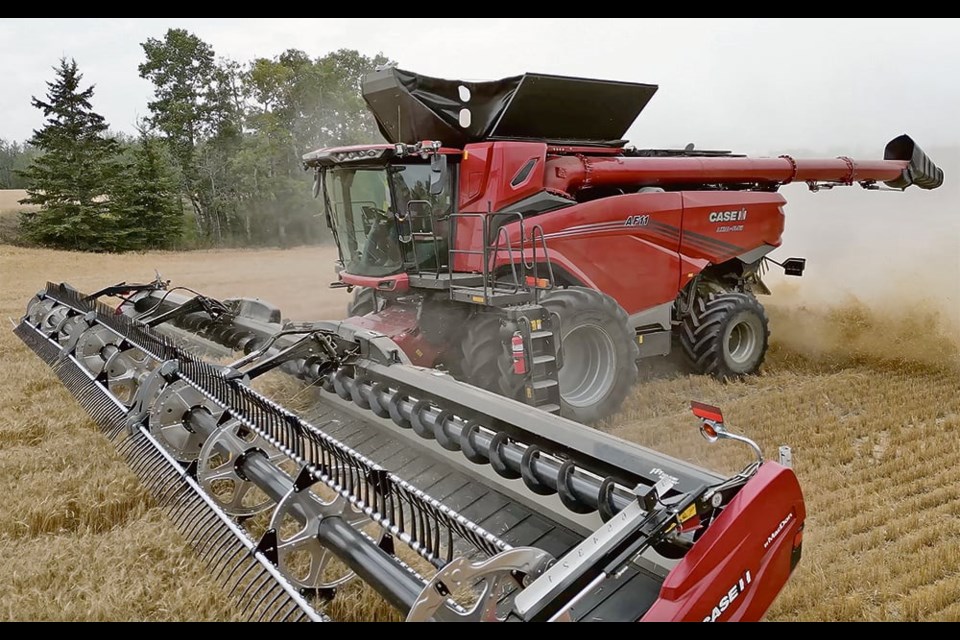WESTERN PRODUCER — Following on the heels of the introduction of the machinery show in Germany in November, sister brand Case IH has just introduced its version of that Class 10-Plus combine, the .
This red giant with a 567 bushel grain hopper makes its first public appearance at the National Farm Machinery Show in Louisville, Kentucky this month.
“(It’s) our entry into that Class 10-Plus segment,” said Leo Bose, harvesting segment leader at .
“Producers are looking not only for capacity but technology and run time. The AF11 delivers on those three pillars.”
With its AFXL2 dual rotor system, the AF11 becomes Case IH’s first dual rotor combine, an engineering concept its sister brand has been embracing for almost 50 years.
Bose said the combine is a clean-sheet design compared to the brand’s current models, meaning it has been completely re-engineered to provide those productivity and efficiency gains.
“The rotors are physically longer and they’re dual,” said Bose.
The AF11 also gets a wider feeder house to provide room for the combine to suck up all that crop material to keep the rotors fed.
“The AFS 11 has been redesigned from the ground up with a longer wheelbase,” Bose said.
“We know headers are getting wider, so we can go up to 50 feet at this time, and we can carry up to 15,000 pounds (6,800 kilograms) on the feeder house for that header.
“We widened out the feeder. We use a synchronized feed system. It allows us to do two things. It provides rock protection, but it also synchronizes the speed of the crop mat coming into the rotor. As I speed up or slow down the rotor, that feed system is going to speed up or slow down. We can adjust the feeder house chain speed to really push the capacity of the machine.”
The AF11 uses a newly designed cleaning system to improve the grain quality going to the hopper and reduce the amount of grain loss out the back end.
“It’s a whole new cleaning system,” Bose said.
“It allows us to start with a cross flow plus cleaning fan. We’ve increased the fan diameter, which allows us to create more air volume. We can run that fan at a slower speed as well. That allows us to save on horsepower.
“It was totally reimagined. It allows us to take a four-sieve approach. We call it an active and dynamic cleaning system. It allows us to take the (crop) mat and even it out. On level ground or on 13 percent slope we can now have more efficiency in the cleaning system.
“We can sense the air pressure left and right in the cleaning system. We know if the system is loading one side or the other, and we do that through automation. The cleaning system can move that crop to get a nice even level.”
At six bushels per second, the unloading auger can empty the hopper in just over a minute and a half. And at the back end the new spreader system provides a consistent, even spread pattern across the full header width.
“We’re seeing residue spread that can go past the width of the header,” said Bose.
“We have what we call radar spread automation. Now we can adjust automatically, without operator input, to make sure we have that consistent, uniform spread.”
The AF11 uses the same 16-litre diesel engine that powers the new , which can deliver 775 peak horsepower. It will be available in wheeled or tracked versions.
According to the brand’s announcement, the AF11 is “the first in the AF Series and will offer a number of top-of-the-line technology-focused features, including Case IH’s combine automation solution, Harvest Command.”
The “first in the AF Series” reference seems to suggest more twin-rotor machines will be wearing Case IH branding in the future.
AF11s will see limited production for the 2024 season until the brand is able to expand to full production in 2025.




